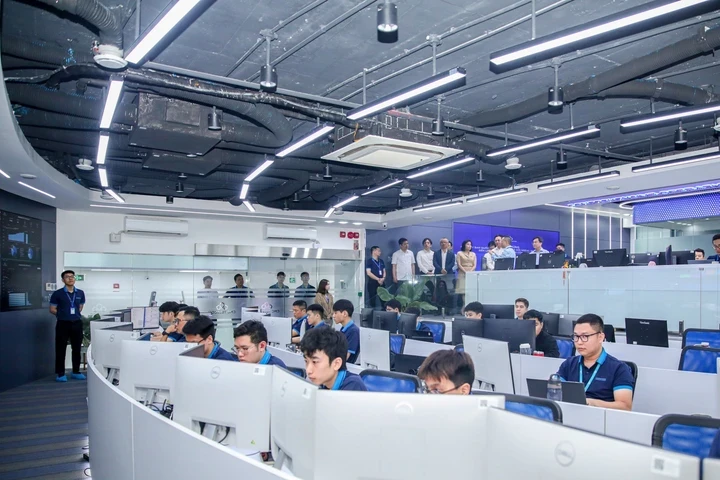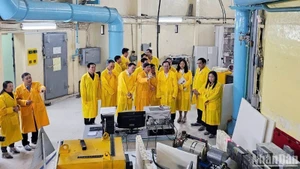In the operation of the two-tier local government, digital technology is regarded as the foundation for the transformation process, ensuring that a streamlined apparatus can still function effectively. To prevent service disruptions when transitioning from the three-tier system to the two-tier government model and to ensure smooth online public administrative procedures for citizens, localities have issued resolute directives and implemented innovative approaches.
Positive beginnings
Immediately upon the model's implementation on July 1, Ninh Binh Province deactivated the old e-government information systems of the former three provinces and transitioned to a new shared system. The initial operation of the two-tier government model in localities has yielded positive outcomes, especially for residents. Administrative procedures can now be completed at one’s current place of residence instead of having to return to their registered permanent address as before. This smooth start is attributed to Ninh Binh's prior pilot implementation of the two-tier local government model, which served as a full-scale rehearsal with real situations, real procedures and real personnel.
The trial operation allowed the locality time to review all processes and systems. In addition, key technology units such as VNPT Ninh Binh not only directly built and operated the digital infrastructure for the province's new model but also conducted multiple rounds of technical support at the grassroots level. “We assigned two permanent staff members to each commune and ward, and formed a 24/7 Zalo technical support group to resolve any issues that arise on the ground. In the coming period, we will continue refining, adjusting and upgrading systems and software to meet the evolving operational needs of the two-tier government model,” said a representative of VNPT Ninh Binh.
In Thai Nguyen, configuring and adjusting software and data systems to match the newly merged administrative structure has been considered more complex, as the entire solution was deployed from scratch. Dao Ngoc Tuat, Deputy Director of the Thai Nguyen Provincial Department of Science and Technology, confirmed that technically, the local transmission network is now 100% secure. “Network providers have proactively doubled the bandwidth. All communes and wards now have a minimum bandwidth of 100 Mbps. We have also split the network system at the Public Administrative Centre, one part serves the public, the other is dedicated for officials to access the national population database.”
Seamless operation in the digital environment also helps citizens access public services more easily following changes in administrative boundaries. Residents in some areas have initially noted greater convenience in certain public administrative services. The sending and receiving of electronic documents, as well as the updating and processing of online records, are carried out more quickly. Some individuals said that searching and submitting feedback via software systems reduced travel time, especially for simple procedures.
Continuing to solve difficulties
In the early stages of implementing the new model, some localities still faced difficulties. At the Ninh Binh Provincial Public Administrative Service Centre, many staff reported network congestion, software errors, and incomplete display of information in the new system. In practice, data fields were sometimes misaligned or not visible, leaving staff uncertain on how to process citizen records. Even at the provincial level, where public administration officers are more professionally trained, there was still some confusion when using the new software and systems.
Some administrative procedures that were previously handled at the district level have now been transferred to the commune level. However, commune officials have not previously engaged with them. Therefore, localities still need time to update procedures, reconfigure them in the digital environment, and train their personnel.
Deputy Director of the Ninh Binh Department of Science and Technology Ta Quang Phuong.
Furthermore, many officials have not been issued digital signatures to process public service procedures for citizens, leading to delays in finalising records. Ngo Manh Tai, Director of the Trung Thanh Ward Public Administrative Service Centre (Thai Nguyen Province), expressed the need to appoint a dedicated IT officer to directly handle issues that arise locally, as current staff have only received basic IT training.
Interoperability between provincial software systems and those of ministries, national agencies, such as the National Public Service Portal, the Population Database System, and the Civil Registry System, as well as decentralisation and delegation of authority on the systems, remains a major challenge.
Although the goal is to build a two-tier government to reduce intermediate layers, in reality, there are still no specific guidelines on the delegation and decentralisation of some administrative procedures. Deputy Director of the Ninh Binh Department of Science and Technology Ta Quang Phuong stated that some procedures formerly managed by the district level have now been assigned to communes, but commune staff have never dealt with them before. Therefore, time is still needed to update workflows, configure them on digital platforms, and provide training.
Lack of standardised equipment is also a barrier to implementing online public administrative procedures. While the facilities in some wards and communes in Thai Nguyen are basically adequate, those in many others are still lacking. None of the civil servants' computers have licensed software as required under Plan No. 02-KH/TW, and many devices are outdated and no longer compatible with the requirements of digital operation.
In Nam Hoa Lu Ward, the equipment needed to fulfil administrative tasks is still limited, hindering smooth digitalisation of records. Moreover, unfamiliarity among citizens with digital services is another obstacle. In our interviews, many people admitted they were still reluctant to submit documents online due to a lack of proficiency with smartphones, particularly among the elderly.
To ensure the two-tier government model is truly effective, a range of coordinated and decisive solutions must be implemented in the coming period. These include ensuring stable data transmission connectivity between localities and the National Population Data Centre; restructuring new modules and making them available on the “Digital literacy for all” platform to directly train officials and civil servants; reassessing the need for equipment such as USB tokens and digital signatures; and publishing the locations of new public service procedures to make them more accessible to the public.
















